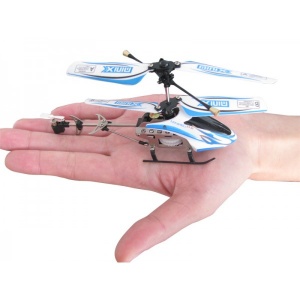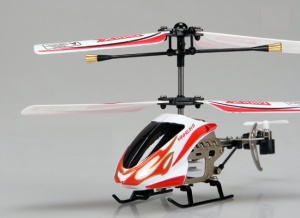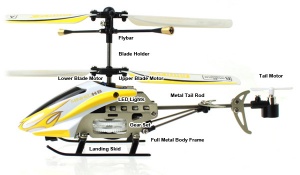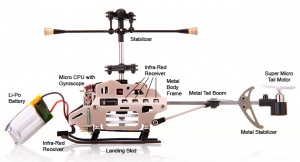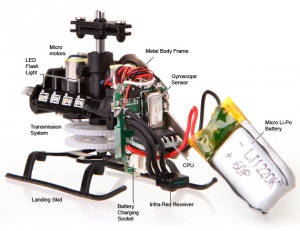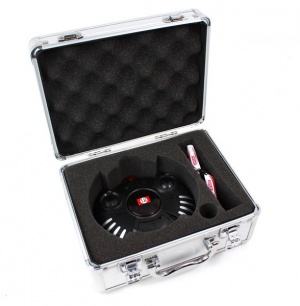Copter 6025-1
The is a tiny tiny coaxial aluminium frame helicopter with a gyro and infrared controller. A small vertically mounted tail rotor is used to provide fast forward and backward elevation.
Specifications
- Motor: 2 solid motors for coaxial, 1 tail motor for elevation
- Remote: Infrared, 3 band switch, 3 channels, integrated charger, 6x AA batteries
- Controls: Elevator (for/aft), yaw (rotate), throttle (lift), and elevation speed (hi/low .5CH)
- Battery: 60 mAh 3.7V (1-Cell) Lithium-Polymer
- Charging connection on left-side
- Charging: 20 minutes
- To dis-engage charging mode, move throttle stick up and down
- Runtime: approx. 4-5 minutes
- Soft cut-off on low battery
- Weight: 16.3 grams
- Dimensions: 113x22x60mm (LxWxH)
- Main rotor diameter: 110mm
Sanhuan documents:
- Sanhuan Copter 6025-1 Mini-X product page - Store page
- Sanhuan Copter 6020/6020-1/6023-1/6025-1 operation manual
Setup
- For the first 5 flights, only run the battery down to 50%, 1.5 minute flighttime, it will help lengthen the life of the LiPo
- If it swings or wobbles when in hover, try to fasten one or both blades (upper/lower)
- Let the motors cool off after a flight, 5-10 minutes
- Check the tail rotor for plastic residue left from the manufacturing
- To enter forward flight mode, remove the tail fin, boom support, and skids, I think this is how it should fly by default! Weight: 15.1 grams
- Optionally, bend the skid support screw-tabs down to raise the body above the on/off-switch sticking out. Note that the tabs will now catch most of the force on a crash and will eventually break off.
- When on crash course, immediately push/kill the throttle to low to avoid unnecessary motor and blade wear
- Avoid adding grease, tri-flow oil, or silicone oil, it seems to have an adverse effect on the flight characteristics
- Its metal frame and general good design allows for an amazing amount of improper handling and crashing without much or any damage at all, 1.5m free-fall no problem
- If the copter unexpectedly loses power and the controller LEDs begin to blink when throttle stick is at full, recharge the controller batteries
- Also, power loss can happen if the infra-red signals cannot be reflected/bounce of walls, i.e. in large rooms or outdoors
Possible tweaks
- Mount small E-flite battery between the skids
- Replace battery with higher capacity E-flite battery [1]
- Removable battery with connector
- Improve cooling of the motors
- Metal fins, funnel, thermal grease
- Remove spring on throttle stick
- Replace metal screws with nylon
- Use higher quality LiPo batteries
- Connect batteries in parallel for double capacity
- Balance weight and flight performance
- Disable LED lights
- Swap controller trim-pot polarization
- Program a better controller
- Different size flybar weights
- Swap the left and right control stick [10]
- For Throttle and Yaw on left and Elevation on right
Battery
The standard battery is a 3.7V 60 mAH Lithium-Polymer cell. From my tests, the standard controller charger does a good job. Comparing it against a dedicated Bantam BC6, it supplied the same power, 59-62 mAh. The controller seems to charge at 0.2-0.3 mA.
Doing a stationary test on two different copters and averaging the results, I found:
- Power-on standby: 0.02A
- Minimum driving throttle: 0.3A
- Full throttle: 0.71A
- Both motor stalled: 1.4A
- Going right: 0.57 (decreases 0.14A)
- Going left: 0.75 (increases 0.04A)
- Forward and backward tail motor: 0.15A
- Full throttle and forward 0.85A
The stall amperage suggests that the standard cell is capable of 20C, i.e. 20 times the discharge rate of the cell's capacity, how fast it can supply the electrons.
This graph shows charging at 0.1A using the Bantam BC6:
File:Helicopter 6025-1 charging 0.1a bc6.png
Discharging at 0.5A using the BC6:
File:Helicopter 6025-1 discharging 0.5a bc6.png
Discharging at 1.0A using the BC6:
File:Helicopter 6025-1 discharging 1.0a bc6.png
As the graph shows, the supply voltage drops considerably when the load increases. Thus it's important to minimize any unnecessary load and resistance.
Spare parts
List of spare parts and accessories for the 6025-1:
- Copter MINIX Heli 6025 70mAh Lipo Battery [11] [12]
- Copter MINIX Heli 6025 Landing Skid [13]
- Copter MINIX Heli 6025 Tail Main Blade Set [14] [15]
- Copter MINIX 6025 Tail Rotor Blades [16] [17]
- Copter Mini X 6025-1 Motor [18]
- Copter Mini X 6025-1 Tail Boom w/ Tail Motor [19]
Accessories:
- Copter V-MAX/MAX-Z 6020 USB Cable [20]
- RC Pro X Aluminium Box for SanHuan Copter Mini X 6025-1 [21]
- 3DPro AluSafe Portable Aluminium Case for Walkera 4#3A/B, CB100 [22] - little bigger, no pre-fit
These suppliers offer original 6025 spare parts:
- rc711.com - 6025-1 spare parts
- rc-fever.com - 6025-1 spare parts
- okhobbu.hk - good prices
- precisionmicrodrives.com - motors
- yessuprise.com - 6025-1 spare parts
Similar mini helicopers
- Nine Eagles Free Spirit Micro 210A [23]
- E-flite Blade mSR [24]
- SanHuan Copter 6023-1 [25] [26]
- E-flite Blade mCX [27] [28]
- Nine Eagles Solo [29] - Revell Proto CX (rebranded) [30] [31]
- Sanhuan Copter 6023-1 [32]
